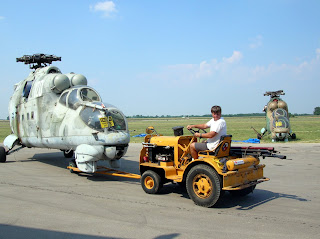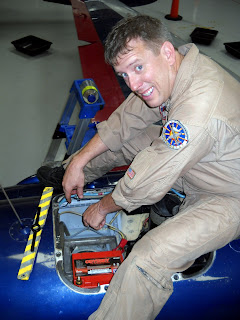My friend Bernd, who ran an East German
L-39 squadron, is an adviser to the museum although I'd never met him in person. He has an amazing knowledge of L-39s and also stocks parts — which makes him a great resource when you've got a Plane Problem — but his great sense of humor and gracious nature makes him the sort of guy you feel lucky to know under any circumstances.

For several years I'd been threatening to come to the music festival held at the beginning of May in Bautzen, Germany near where he lives. One can only threaten for so long before one has to make good on the threats or drop the ruse. So we packed our bags at the end of April and headed East. Way East. East Germany East. "Almost Poland" East. For three days Bernd took us around in his Blue Opel Wonder Van and showed us the sights. It was a truly memorable trip... we took over 500 photos!
One of the days, as we were going along, Bernd said, "There's something I'd like to show you." We were near the Taucher Forest, near Uhyst am Taucher.


We stopped and got out of the van at what looked like a kind of a state park. Bernd explained that the Russians had come and built a military installation in the woods in early 1984. It was very secret and an absolutely prohibited place. The trees were quite tall, and you could have hidden anything in here. The Russians dug a 4km trench — by hand — to run power from a nearby substation. The people from the nearby town offered some ditch-digging equipment to help, but the Russians said no, no, they'd be doing this by hand... in an area where the ground quickly turns to granite not too far under the topsoil. He pointed out the posts for the outer fence and then for the inner, electrified fence. When he explained that no-one from the town was allowed into the installation, that when the supply truck came out the driver would have to get out and someone from inside would then drive the truck in... I thought I heard Scary Organ Music, but perhaps it was just the wind in the trees. :-)
Eventually we got to some concrete tracks that lead away from the main trail in the woods. "I think it's up here," he said. The tracks were made from a kind of reinforced concrete, the kind that would support heavy equipment. We followed them deeper into the woods.

And there it was. A massive bunker, one of 16 that had held SS-22 IRBM nuclear missiles. The missiles had been installed in response to the Pershing II and cruise missile deployment by NATO in West Germany.

The missiles were removed in 1988 as part of the Intermediate-Range Nuclear Forces Treaty. Since the treaty only covered the destruction of the
launchers, the Pershing II missiles and about 100 nuclear warheads are still with NATO in Germany.
Bernd sent me a photo of a friend's son on one of the launch vehicles taken when the missiles were being removed:

In order to launch the missiles, the trucks would drive out of the bunkers to one of the launch pads, basically clear circles in the woods, and tilt the missiles skywards. This could be done very quickly.

Every year a group meets at the site to commemorate the removal of the missiles and pray that we never get so close to blowing each other to Kingdom Come ever again. A small cross marks the spot where they meet.
 After a first flight in 1948, the GM-1, designed by the Mil OKB, won a state competition to become the first operational helicopter in Soviet Military service. Publicly displayed for the first time in 1951 while U.S. helicopters were first being featured in newsreels during the Korean conflict, the Mi-1 was given the code name "Hare" by NATO.
After a first flight in 1948, the GM-1, designed by the Mil OKB, won a state competition to become the first operational helicopter in Soviet Military service. Publicly displayed for the first time in 1951 while U.S. helicopters were first being featured in newsreels during the Korean conflict, the Mi-1 was given the code name "Hare" by NATO. The Mi-1 carried a pilot and three passengers and was powered by a seven-cylinder air-cooled radial Ivchenko AI-26V piston engine, providing 575 HP. The engine and transmission were located in the main fuselage, where the extended crew and cargo area of the Mi-2 (NATO code name "Hoplite") is found.
The Mi-1 carried a pilot and three passengers and was powered by a seven-cylinder air-cooled radial Ivchenko AI-26V piston engine, providing 575 HP. The engine and transmission were located in the main fuselage, where the extended crew and cargo area of the Mi-2 (NATO code name "Hoplite") is found. The instruments of the Mi-1 reflect simpler times and systems.
The instruments of the Mi-1 reflect simpler times and systems. 

















































